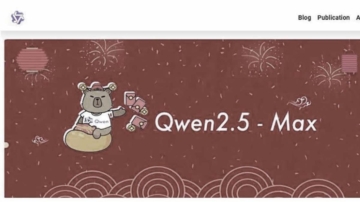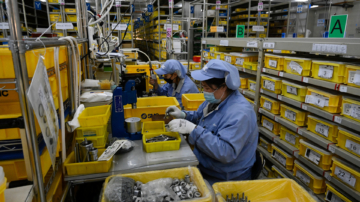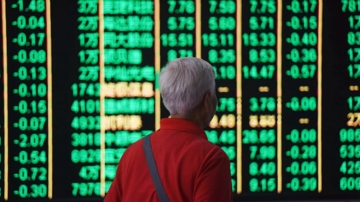【新唐人2014年02月18日訊】法國銀行業巨頭「興業銀行」警告說,2014年中國經濟「硬著陸」風險增大。有專家甚至指出,代表國民生產總值的中國GDP增速,可能下降到2%。下面請看專家分析。
據《美國之音》報導,法國「興業銀行」日前發表的報告中估計,中國今年的經濟增長率為6.9%,低於中國政府設立的7.5%的目標和國際貨幣基金組織的預期,「硬著陸」的風險正在增加。
「興業」對中國2014年「硬著陸」的定義為﹕全年GDP實際增長率跌到5%以下。這個機構認為,這是維持就業市場穩定,避免系統性金融風險的最低限度。
「興業銀行」經濟師帕特裡克•萊格蘭德公開指出,危機最嚴重時,經濟同期增長率可能會下降到2%。
中國金融智庫研究員鞏勝利:「它兩難境地,一個是貨幣投放量歷史最高,02年的時候,人民幣的貨幣總量大概只有16萬億,現在是110萬億,還有一個參照,中國的GDP只有美國的差不多一半,但是中國花出去的貨幣是美國的1.5倍,中國還一直在喊錢緊錢緊。」
按照慣例,每年的12月份和1月份,都是中國銷售和生產的最高峰期,但是,據中共官方公布的數字,去年12月,中國經濟發展速度下降到7.7%,而應該在2月12號公布的今年1月份GDP指數,現在還沒有公布,據說是因為GDP數字太難看。
1月21號,人民幣兌美元吃緊,央行放水2500億救市,2月1號到2月12號之間,人民幣對港幣的牌價連續跌了10天,跌幅超過7%,去年全年,人民幣對美元的升幅只有3%。
鞏勝利:「美國的貨幣投放現在才減少了200億,現在(中國)就到了強力拉不開栓,人走不動路,馬失前蹄,掉下來,如果美國每個月850億全部退出,又會造成甚麼樣的結果?」
根據中國銀監會星期四公布的數據,去年第四季度,中國商業銀行「不良貸款餘額」為5921億元,比第三季度增長了285億元,連續九個季度上升。
鞏勝利:「背後的還有一些,因為中國的商業銀行,特別是四大家,他們都是股份制上市企業,他們的那些壞資產,死的資產已經都剝離了,現在又從新堆積了它的債務,每一家銀行後面都有一個資產管理公司,處理以前的債務,他的債務關鍵是在那邊了,那邊你看不到。」
美國南卡羅萊納大學艾肯商學院教授謝田:「更難辦的問題是影子銀行的問題,理財產品大面積的違約恐怕馬上就會到來,政府是不是去救助,救助到甚麼程度,這些理財產品涉及到影子銀行的問題,涉及到地方債的問題,這些總體債務的迸發才是更大的問題。」
許多分析師相信,中國真實的不良貸款比例比官方公布的數字更高,因為銀行可以通過「借新債還舊債」來掩蓋壞賬。
而據中共國家統計局最近公布的數字,代表工業生產者出廠價格指數的PPI同比下降1.6%,連續下降了23個月,接近兩年。而全國居民消費價格總水平卻同比上漲了2.5%。
鞏勝利:「貨幣的成本高,其他所有的行業成本就高起來,成本高了以後,一個是使用貨幣的人,他使用不起,成本高,還有一個,如果企業不能夠很好的使用貨幣,銀行的呆賬、死賬、爛賬就會增加, 持續走下去的話,債務鏈接越接越大,最後脫不動了,只有死亡。」
目前中國銀行的貨幣利率達到6.2%左右,在全球20個大國中,中國的貨幣運行成本是最高的,美國的利率維持在0到0.25% 。
不過中國金融智庫研究員鞏勝利指出,如果中國經濟崩盤,對全球不會產生太大影響,因為中國經濟只佔全球的7%,而貨幣影響更小,儲備貨幣只佔0.1%,每一天在全球的人民幣運行只相當於1880億美金。鞏勝利說,美國的經濟對全球影響非常大,因為美國的經濟佔全球的20%,而美元每天在全球的運行達到4萬6000億之多。
採訪編輯/劉惠 後製/孫寧
Expert: China Hard Landing with Expected 2% GDP Growth
French banking giant Societe Generale (SocGen) warned China of the risk of a hard landing in 2014. It is analyzed that China's GDP might drop to 2%.
The following is the experts' analysis.
It is reported that SocGen has recently estimated a 6.9% economic growth for China this year, below the consensus 7.5% and the risk of hard landing is mounting.
According to Societe Generale, a hard landing scenario would see full-year, real GDP growth fall below 5%, a level believed to be the minimum to maintain the market and avoid financial crisis.
Societe Generale's Patrick Legland thinks at the peak of a crisis the year-on-year growth rate would dip to 2%.
Gong Shengli, Chinese financial think tank researcher:
"This is a dilemma. For one, the cash injection has been the historic high.
There was about 16 trillion RMB in circulation in 2002, now it is 110 trillion RMB. And the other is that China's GDP, about half of the United States,
but China spends at 1.5 times as much as the United States, and China is still complaining of tight cash flow."
In China, both December and January are the peak for sales and production.
Recent official data showed China's economic growth rate dropped to 7.7% last December. While the January data supposed to be reported on Feb. 12
has not been released. It is said that it is because the GDP was too low to show.
On January 21, the RMB to the U.S. dollar went down and forced the central bank to inject 250 billion RMB to save the market.
Between Feb. 1 and Feb. 12, the RMB against the Hong Kong dollar fell continuously for 10 days, with a decline of more than 7%, while throughout last year the RMB against U.S. dollar rose only by 3%.
Gong Shengli: "America's money supply was only reduced by 20 billion and China has started to tumble. What would happen if the United States completely withholds its monthly 85 billion printing now?"
According to China Banking Regulatory Commission's release Thursday, the fourth quarter of last year, the balance of non-performing loans of Chinese commercial banks was 592.1 billion yuan, accounted for an increase of 28.5 billion yuan
from the third quarter, and the growth for ninth consecutive quarters.
Gong Shengli: "There are also debts hidden. China's commercial banks, especially the four major banks, are joint-stock companies. Their dead debts had been written off as uncollectable and managed by the asset management company. However, the banks continue to build new debts. The key is in the debt at the management company, but we don't get to see it."
Xie Tian, School of Business Professor, University of South Carolina Aiken: "The shadow bankings are even more difficult to handle. Massive default on the trust products is probably just around the corner. Will the government intervene and to what extent? These trust products are related to the shadow bankings and
local debts. The overall debt outbreaks will impose the major crisis."
Analysts believe that the non-performing loans are much higher than the official data, because banks tend to cover up bad debt by refinancing the old debts.
The Chinese National Bureau of Statistics revealed the January producer price index (PPI) for manufactured goods decreased 1.6 percent year-on-year, and decreased for 23 consecutive months, whereas the consumer price index (CPI)
went up by 2.5 percent year-on-year.
Gong Shengli: "The high money cost raises all costs at the industries. People will not be able to afford the high cost is for one, and the industries will not have an effective use of the money and increase banks' bad debts. In the long run, the debt chain will only grow and finally kill the entire system."
China banks' currency rate is around 6.2%. Among the 20 major countries in the world, China's currency has the highest operating costs, whereas the U.S. interest rates remain at 0 to 0.25%.
But Chinese financial think tank researcher Gong Shengli indicates that in the event of China's economic collapse, the impact on the global economy will not be much, because China's economy accounts for only 7% of the world.
The currency effect is even smaller, because its reserve currency takes only 0.1%, and daily circulating RMB is only accounted for 188 billion dollars.
However, the U.S. economy will have a major impact to the world for it occupies 20 % of the world economy, and daily circulating U.S. dollar is as high as 4.6 trillion.
Interview & Edit/LiuHui Post-Production/SunNing
據《美國之音》報導,法國「興業銀行」日前發表的報告中估計,中國今年的經濟增長率為6.9%,低於中國政府設立的7.5%的目標和國際貨幣基金組織的預期,「硬著陸」的風險正在增加。
「興業」對中國2014年「硬著陸」的定義為﹕全年GDP實際增長率跌到5%以下。這個機構認為,這是維持就業市場穩定,避免系統性金融風險的最低限度。
「興業銀行」經濟師帕特裡克•萊格蘭德公開指出,危機最嚴重時,經濟同期增長率可能會下降到2%。
中國金融智庫研究員鞏勝利:「它兩難境地,一個是貨幣投放量歷史最高,02年的時候,人民幣的貨幣總量大概只有16萬億,現在是110萬億,還有一個參照,中國的GDP只有美國的差不多一半,但是中國花出去的貨幣是美國的1.5倍,中國還一直在喊錢緊錢緊。」
按照慣例,每年的12月份和1月份,都是中國銷售和生產的最高峰期,但是,據中共官方公布的數字,去年12月,中國經濟發展速度下降到7.7%,而應該在2月12號公布的今年1月份GDP指數,現在還沒有公布,據說是因為GDP數字太難看。
1月21號,人民幣兌美元吃緊,央行放水2500億救市,2月1號到2月12號之間,人民幣對港幣的牌價連續跌了10天,跌幅超過7%,去年全年,人民幣對美元的升幅只有3%。
鞏勝利:「美國的貨幣投放現在才減少了200億,現在(中國)就到了強力拉不開栓,人走不動路,馬失前蹄,掉下來,如果美國每個月850億全部退出,又會造成甚麼樣的結果?」
根據中國銀監會星期四公布的數據,去年第四季度,中國商業銀行「不良貸款餘額」為5921億元,比第三季度增長了285億元,連續九個季度上升。
鞏勝利:「背後的還有一些,因為中國的商業銀行,特別是四大家,他們都是股份制上市企業,他們的那些壞資產,死的資產已經都剝離了,現在又從新堆積了它的債務,每一家銀行後面都有一個資產管理公司,處理以前的債務,他的債務關鍵是在那邊了,那邊你看不到。」
美國南卡羅萊納大學艾肯商學院教授謝田:「更難辦的問題是影子銀行的問題,理財產品大面積的違約恐怕馬上就會到來,政府是不是去救助,救助到甚麼程度,這些理財產品涉及到影子銀行的問題,涉及到地方債的問題,這些總體債務的迸發才是更大的問題。」
許多分析師相信,中國真實的不良貸款比例比官方公布的數字更高,因為銀行可以通過「借新債還舊債」來掩蓋壞賬。
而據中共國家統計局最近公布的數字,代表工業生產者出廠價格指數的PPI同比下降1.6%,連續下降了23個月,接近兩年。而全國居民消費價格總水平卻同比上漲了2.5%。
鞏勝利:「貨幣的成本高,其他所有的行業成本就高起來,成本高了以後,一個是使用貨幣的人,他使用不起,成本高,還有一個,如果企業不能夠很好的使用貨幣,銀行的呆賬、死賬、爛賬就會增加, 持續走下去的話,債務鏈接越接越大,最後脫不動了,只有死亡。」
目前中國銀行的貨幣利率達到6.2%左右,在全球20個大國中,中國的貨幣運行成本是最高的,美國的利率維持在0到0.25% 。
不過中國金融智庫研究員鞏勝利指出,如果中國經濟崩盤,對全球不會產生太大影響,因為中國經濟只佔全球的7%,而貨幣影響更小,儲備貨幣只佔0.1%,每一天在全球的人民幣運行只相當於1880億美金。鞏勝利說,美國的經濟對全球影響非常大,因為美國的經濟佔全球的20%,而美元每天在全球的運行達到4萬6000億之多。
採訪編輯/劉惠 後製/孫寧
Expert: China Hard Landing with Expected 2% GDP Growth
French banking giant Societe Generale (SocGen) warned China of the risk of a hard landing in 2014. It is analyzed that China's GDP might drop to 2%.
The following is the experts' analysis.
It is reported that SocGen has recently estimated a 6.9% economic growth for China this year, below the consensus 7.5% and the risk of hard landing is mounting.
According to Societe Generale, a hard landing scenario would see full-year, real GDP growth fall below 5%, a level believed to be the minimum to maintain the market and avoid financial crisis.
Societe Generale's Patrick Legland thinks at the peak of a crisis the year-on-year growth rate would dip to 2%.
Gong Shengli, Chinese financial think tank researcher:
"This is a dilemma. For one, the cash injection has been the historic high.
There was about 16 trillion RMB in circulation in 2002, now it is 110 trillion RMB. And the other is that China's GDP, about half of the United States,
but China spends at 1.5 times as much as the United States, and China is still complaining of tight cash flow."
In China, both December and January are the peak for sales and production.
Recent official data showed China's economic growth rate dropped to 7.7% last December. While the January data supposed to be reported on Feb. 12
has not been released. It is said that it is because the GDP was too low to show.
On January 21, the RMB to the U.S. dollar went down and forced the central bank to inject 250 billion RMB to save the market.
Between Feb. 1 and Feb. 12, the RMB against the Hong Kong dollar fell continuously for 10 days, with a decline of more than 7%, while throughout last year the RMB against U.S. dollar rose only by 3%.
Gong Shengli: "America's money supply was only reduced by 20 billion and China has started to tumble. What would happen if the United States completely withholds its monthly 85 billion printing now?"
According to China Banking Regulatory Commission's release Thursday, the fourth quarter of last year, the balance of non-performing loans of Chinese commercial banks was 592.1 billion yuan, accounted for an increase of 28.5 billion yuan
from the third quarter, and the growth for ninth consecutive quarters.
Gong Shengli: "There are also debts hidden. China's commercial banks, especially the four major banks, are joint-stock companies. Their dead debts had been written off as uncollectable and managed by the asset management company. However, the banks continue to build new debts. The key is in the debt at the management company, but we don't get to see it."
Xie Tian, School of Business Professor, University of South Carolina Aiken: "The shadow bankings are even more difficult to handle. Massive default on the trust products is probably just around the corner. Will the government intervene and to what extent? These trust products are related to the shadow bankings and
local debts. The overall debt outbreaks will impose the major crisis."
Analysts believe that the non-performing loans are much higher than the official data, because banks tend to cover up bad debt by refinancing the old debts.
The Chinese National Bureau of Statistics revealed the January producer price index (PPI) for manufactured goods decreased 1.6 percent year-on-year, and decreased for 23 consecutive months, whereas the consumer price index (CPI)
went up by 2.5 percent year-on-year.
Gong Shengli: "The high money cost raises all costs at the industries. People will not be able to afford the high cost is for one, and the industries will not have an effective use of the money and increase banks' bad debts. In the long run, the debt chain will only grow and finally kill the entire system."
China banks' currency rate is around 6.2%. Among the 20 major countries in the world, China's currency has the highest operating costs, whereas the U.S. interest rates remain at 0 to 0.25%.
But Chinese financial think tank researcher Gong Shengli indicates that in the event of China's economic collapse, the impact on the global economy will not be much, because China's economy accounts for only 7% of the world.
The currency effect is even smaller, because its reserve currency takes only 0.1%, and daily circulating RMB is only accounted for 188 billion dollars.
However, the U.S. economy will have a major impact to the world for it occupies 20 % of the world economy, and daily circulating U.S. dollar is as high as 4.6 trillion.
Interview & Edit/LiuHui Post-Production/SunNing








